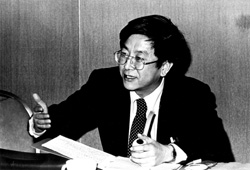Conference Studies "Cosmic Connection"
Over 500 scientists from around the world are expected to attend a conference at Fermilab Oct. 20-22, 1977. For the first time, physicists working in two frontier areas of science--particle physics and cosmology -- will unite to explore the relationship of the universe to inner space of the atom.
The "Ben Lee Memorial International Conference on Parity Nonconservation, Weak Neutral Currents and Gauge Theories" will be held in the Auditorium. The meeting is dedicated to the late Dr. Benjamin W. Lee, Fermilab Theory Department head killed in an auto accident June 16. Dr. Lee was one of the original organizers of the conference.
A memorial address is set for 5 p.m. on Thursday, Oct. 20, opening day of the session. Dr. C.N. Yang, a 1957 Nobel Prize winner and a former colleague of Dr. Lee at the State University of New York-Stonybrook, will speak.
R.R. Wilson, Fermilab director, will welcome researchers at 9 a.m. on opening day to launch the assembly. Among speakers on 33 topics to be presented are Fermilab experimenters A.K. Mann of the University of Pennsylvania and Leon Lederman from Columbia University.
David Cline, University of Wisconsin physics professor and a colliding beam studies experimenter at the Laboratory, is conference chairman. "We are bringing together an outstanding group of people to lend a lot of good thinking to this meeting," he said.
"This is a conference whose time has come. Two years ago this conference would not have been possible; two years from now it might not be necessary."
He added, "Right now we need to bring the best thinking together from several disciplines to see what we have in common. Many of us who have arranged the conference think there will be some surprises!"
He said visiting scientists will explore the possibility that new discoveries and theories in particle physics might parallel current findings in astrophysics. A conjectural bond between particle physics, atomic physics, nuclear physics and astrophysics will be the meeting's theme.
A startling series of discoveries in the last three years has focused physicists' attention on the first 1/100th second after creation in the "big bang" -- an immense explosion, estimated at more than 10 billion years ago, that created the universe.
The "big bang" theory is the common interest that unites particle physicists and astrophysicists.
The cosmic connection moved from speculation to a solid field of study with the discovery of tiny pieces of the atom dubbed "quarks." Scientists discovered that quarks are building blocks of the protons and neutrons that make up the atom's nucleus. With the discovery came a deeper understanding of forces that create and transform the tiny bits of matter.
The main question scientists ask is: Why do these particles possess the particular weights that they exhibit? Most physicists suspect that the solution to this riddle lies in that first 1/100 second of creation. To make further progress, particle physicists are enlisting the aid of the cosmologists.
In return, the cosmologists can expect benefits. The weights of quarks, it is believed, are the fossil record of an earlier stage of the "big bang" than previously estimated. Until recently, the earliest fossil record of the big bang went back to about the fourth minute... when the universe's supply of hydrogen and helium were formed. Abundances of the gases are leading clues to conditions in the universe at that time.
Cosmologists also worry about less dramatic explosions, called "supernovas," that mark the death of stars. Some exotic forces being studied by particle physicists are believed to play a major role in these explosions.
The conference also commemorates the 20th anniversary of a major scientific discovery, "parity violation." This means that atoms, as well as larger objects, make a distinction between right and left symmetry. It is now believed that this distinction has its roots in the same process that fixed the weights of quarks.
Two opening-day sessions will explore weak neutral currents in particle physics and parity violation. Leaders in research in both of these fields will appear on the program. On Friday, Oct. 21, Madame C.S. Wu of Columbia University will head a discussion of non-conservation of parity at the level of the nucleus. Samuel Ting, 1976 Nobel laureate, will lead the session, "Search for New Particles Beyond Charm."
Also on Friday, M.A. Ruderman, Columbia University, will chair a discussion of weak interactions in astrophysics. A participant is expected to be Cambridge University's Stephen Hawking, originator of dramatic theories about black holes in outer space.
The conference will close Saturday with a summary session by selected outstanding theorists. They will be: Maurice Goldhaber, Brookhaven National Laboratory; David Politzer, Caltech; Frank Wilczek, Princeton University; Sheldon Glashow and Steven Weinberg, Harvard University; Abdus Salam, International Centre for Theoretical Physics, Trieste; and James Bjorken, Stanford Linear Accelerator Center.
Official proceedings of the conference will be published in early 1978.
The conference is the second international proceeding to be held here in Fermilab's 10-year history. High-energy physics topics were explored in the Laboratory's first world wide meeting held in 1972.




